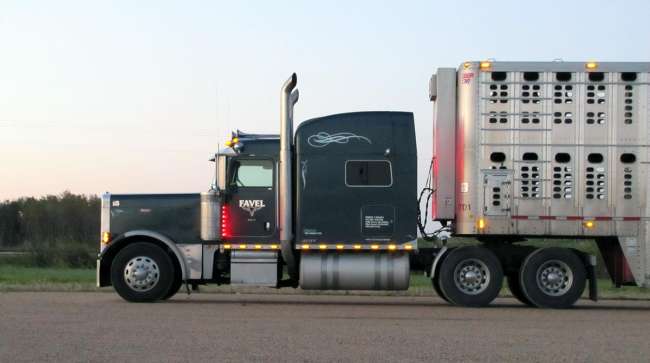Hours-of-Service Truck Driving Law Could Damage Livestock Industry

A new federal law that drastically reduces the number of hours truck drivers can be on the road could seriously affect the livestock industry in Oklahoma and other states where animal production is critical to the economy.
Gage cattle feeder Dale Moore feeds cattle for Robert Gallo of Gallo Winery in Modesto, Calif.
What’s most important to him and Moore is to be able to get his specialized type of cattle quickly and efficiently from his ranch in Modesto to Gage, where he knows they will be handled exactly how he wants them.
“These are program cattle. They are USDA-verified Natural Non-Hormone Treated Cattle program,” Moore says. “So they are verified for all these programs, and they [USDA] have very strict stipulations in order to stay in these programs.
“For instance, these cattle cannot leave the ranch of origin until they have been identified [tagged with electronic ear tags that prove their origin], approved and verified, and they cannot be sold at a sale barn unless the sale barn is approved by the USDA for all those programs. There are only two sale barns like that and both in Nebraska,” Moore said.
Some of the other USDA stipulations on program cattle include where these cattle, produced for customers who want a healthy product with no additives, can be unloaded. And that is the conundrum that sets the stage for this story. And yet this isn’t affecting just cattle producers, it affects all producers who need to transport animals, including bee haulers.
Cattle feeders in Oklahoma and indeed other states known for their expertise in feeding cattle could be hamstrung by a new law that severely limits drivers’ ability to schedule their trips in a way that allows them to care for the animals they are hauling, and it even places livestock and humans at greater risk.
The final rule, signed by President Barack Obama and published December 2015 by the Federal Motor Carrier Safety Administration, is known as the Electronic Logging Devices and Hours of Service Supporting Documents. The law is due to go into effect Dec. 18.
Among numerous other detailed requirements regarding how drivers record their drive times, the 516-page law requires drivers not to have been on duty more than 14 hours and not to have driven more than 11 of those hours. When drivers reach those maximum allotments of time, they will be required to stop and rest for a minimum of 10 hours. The laws are aimed at attempting to reduce the number of accidents involving over-the-road haulers.
In the past, a truck driver could drive for 11 hours, pull over and sleep for 2 hours, extend his drive by that many hours and drive several more hours, and pull over again to get some sleep and then he gets to extend his drive again.
As long as the rest hours added up to the required 10 hours within a certain number of hours, the driver was considered compliant, said Steve Hilker of Cimarron, Kan., chairman of the U.S. Cattlemen’s Association Transportation Committee.
This was perfect for livestock haulers, who need to get their livestock to where they are going in the shortest time possible to protect the health of the animals.
The new rule makes no exceptions for bee and livestock haulers, Hilker says.
Hilker, who owns Steve Hilker Trucking, has been in the livestock hauling business for 35 years. The new rules show a complete disregard for the special circumstances experienced by drivers who are hauling living, breathing cargo, he said.
Hilker and several other producers and transportation professionals met with several U.S. legislators on June 7. They also met with Washington-based FMCSA staff members simply to attempt to have some amendments written into the new rules to allow livestock and bee haulers to be exempt from some of the most burdensome of the regulations.
“Public safety and animal welfare have to come first,” Hilker said. “On June 5th, 6th, and 7th, we got in front of the Senate Ag Committee for both the majority and minority. Everything went real well. When we laid it out what we do and what we are facing, they got it and Sen. [James] Lankford [an Oklahoma Republican] was the best. I didn’t have to explain any of this to him. He might have to end up taking lead on this.”
But when Hilker’s group talked to the FMCSA staff, they didn’t get it and couldn’t even conceptualize what the reality is for livestock haulers, Hilker said.
“There is quite a disconnect [with] what we actually do out here, and that is part of what we are trying to overcome,” Hilker said.
So to understand the effects of the new rules, consider the effects on Gallo’s cattle when they leave Modesto, Moore said.
Under the new regulations, a driver who loads Gallo’s cattle in Modesto would need to stop, depending on the route he took, somewhere near Flagstaff, Ariz. (And that’s optimistic, because he would likely have to stop even earlier.)
Now here is where the law really becomes problematic for more health- and animal-focused producers.
They are trying to adhere to regulations enacted by USDA to prove those animals are produced the way they are supposed to be. This is so that customers who want to purchase antibiotic-free beef, can be assured that it is, indeed, antibiotic-free. When they want to purchase grass-fed, they know they are getting that as well, Moore said.
Now, enter the new FMCSA regulations.
There are no approved facilities where Gallo’s program cattle produced in this way can be unloaded between Oklahoma and California without risking their status in those programs, Moore said.
“Those cattle are going to have to stop, not once but twice, from California to Gage and be offloaded,” Moore said. “It could be detrimental to the cattle, but it will also be an enormous burden on the industry producers and livestock haulers.”
And the facility problem is not peculiar to just Oklahoma and California. It’s true all over the United States, Moore said, and Hilker agrees.
“There is simply no infrastructure to support this law,” Hilker said.
Even with approved facilities and infrastructure, he added, increasing the number of times cattle or any animal is loaded and offloaded increases the stress on the animal and the opportunity for the animal to become injured, and it increases the risk that the driver could be injured loading and offloading numerous times.
Hilker wants legislators to amend the law to recognize that not all truckers are equal. He urges Oklahomans to contact their legislators and let them know how they feel about the effects of the new law on agriculture in the state.
“Yeah, they have got to contact their legislators,” Hilker said, “because it is going to go into effect in December if we don’t get it amended.”
Hilker especially wants legislators to hear his most salient point: Livestock haulers represent a small number of the entire trucking industry in the United States, and yet these new laws unfairly burden them over conventional freight haulers.
That’s because, among other problems, it would create a situation in which they are the only truckers forced to unload their cargo every time they stop to rest — every 11 hours.
“These laws were OK for the J.B. Hunts and the Swifts, who have thousands of trucks on the road, because it fits their business models. There was no comment from them,” Hilker said. “Their drivers drop a trailer, go to rest and then pick up another. It works for them. But they don’t have to consider $100,000 worth of living, breathing animals back there. That is just not an option.”


